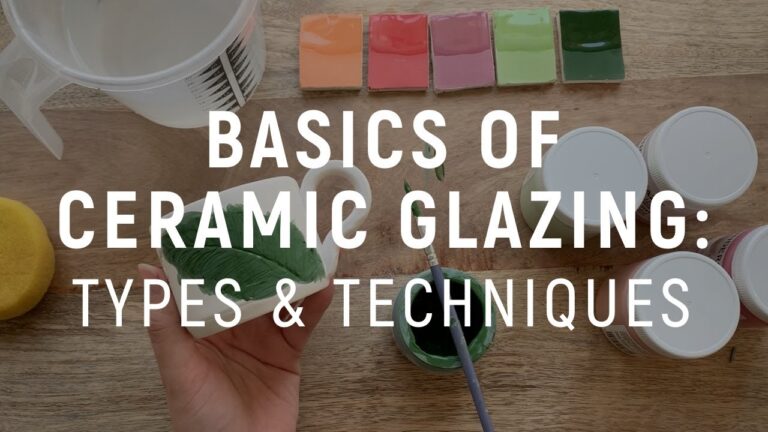Step into the world of ceramics and explore the diverse and distinctive ceramic glazing styles that have captivated artists and collectors alike for centuries. From the vibrant and intricate patterns of majolica to the rich and earthy tones of salt glaze, each style tells a unique story of craftsmanship and creativity. Join us as we delve into the history and techniques behind these mesmerizing glazes, and discover how they continue to inspire contemporary ceramic artists around the globe.
What are the different types of glazes in ceramics?
When it comes to ceramics, the types of glazes you’ll encounter are matte, gloss, and satin. Each of these glazes offers a unique finish and can dramatically change the look and feel of a ceramic piece. Understanding the differences between these glazes can help you choose the perfect finish for your next project.
In ceramics, the three main types of glazes are matte, gloss, and satin. Matte glazes have a flat, non-reflective finish, while gloss glazes provide a shiny, reflective surface. Satin glazes fall in between, offering a subtle sheen that is not too shiny or too dull. Knowing the characteristics of each type of glaze can help you achieve the desired look for your ceramics.
What are the four main types of glazes from the early ceramics period?
During the early ceramics period, four main types of glazes were commonly used: feldspathic, lead, tin, and salt. These glazes were essential in creating a smooth, glass-like finish on pottery and ceramics. Each type of glaze had its own unique properties and characteristics that contributed to the overall aesthetic of the piece.
Feldspathic glazes were made from a mixture of feldspar, quartz, and clay, resulting in a durable and glossy finish. Lead glazes were popular for their ability to create vibrant colors and intricate designs, although they were later found to be toxic. Tin glazes were known for their opaque white appearance and were often used in decorative pottery. Salt glazes were created by throwing salt into the kiln during firing, producing a distinctive orange-peel texture.
While these traditional glazes have been used for centuries, modern technology has allowed for the development of new glazes that do not fit into these four categories. These innovative glazes have opened up a world of possibilities for ceramic artists, allowing them to experiment with new textures, colors, and finishes in their work.
What distinguishes Shino from celadon?
Shino firing, known for its lower temperatures and longer firing periods, contrasts with celadon firing techniques. The slow cooling process of shino firing contributes to its unique aesthetic and depth of color. Additionally, the variety of shino glazes available allows for a range of textures and finishes in pottery.
In comparison to celadon and porcelain firing, shino firing stands out for its distinct characteristics. The lower temperatures used in shino firing result in a more subtle and earthy color palette, differentiating it from the vibrant hues often associated with celadon. Furthermore, shino firing offers artists a diverse array of options when it comes to glaze types and firing methods.
Overall, the difference between shino and celadon lies in their firing processes and resulting aesthetics. While celadon is known for its high-fired, translucent finish, shino firing emphasizes a slower, cooler approach that leads to unique textures and colors. By understanding the distinctions between these firing techniques, artists can explore new possibilities in their pottery creations.
Mastering the Art of Ceramic Glazing
Are you ready to take your ceramic glazing skills to the next level? With our comprehensive guide, you will learn the essential techniques and secrets to mastering the art of ceramic glazing. From understanding different types of glazes to perfecting application methods, this guide covers everything you need to know to create stunning, professional-quality glazed ceramics. Whether you’re a beginner or an experienced artist, our step-by-step instructions and expert tips will help you elevate your glazing game and achieve exceptional results every time.
Unlock the full potential of your ceramic creations with our expert guidance and take pride in your beautifully glazed pieces. With our in-depth knowledge and practical advice, you’ll gain the confidence and skills to experiment with new glazing techniques and develop your own unique style. Say goodbye to mediocre glazing and hello to masterful, eye-catching ceramics that will impress and inspire.
Elevate Your Pottery with Innovative Glazing Techniques
Unleash your creativity and elevate your pottery to new heights with our innovative glazing techniques. Our expert team has curated a selection of cutting-edge methods that will transform your pieces into true works of art. Whether you’re a seasoned pro or just starting out, our techniques are easy to learn and will take your pottery to the next level.
Discover the magic of layering different glazes to create stunning depth and dimension in your pottery. Experiment with bold color combinations and intricate patterns to make each piece uniquely yours. Our techniques will help you achieve a professional finish that will impress even the most discerning of art enthusiasts.
Take your pottery to the next level and stand out from the crowd with our innovative glazing techniques. Elevate your creations with a touch of sophistication and style that will leave a lasting impression. With our expert guidance, you’ll have the tools and knowledge to create pottery that is truly one-of-a-kind.
In the world of ceramic art, distinctive glazing styles add a unique touch to each piece, showcasing the creativity and skill of the artist. Whether it’s the vibrant colors of majolica, the subtle beauty of celadon, or the striking contrast of raku, each style has its own allure. By understanding the characteristics and techniques of these distinctive glazing styles, artists can continue to push the boundaries of their creativity, creating truly one-of-a-kind pieces that captivate and inspire.



